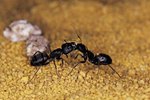
Ants belong to order Hymenoptera and are classified in phylum Arthropoda. They are social insects that live in colonies that may consist of about 20 million individuals. About 10,000 species of ants have been identified. The social systems of ants have different castes including queens, males and workers, with each having a specific responsibility in the colony. Ants undergo a complete metamorphosis that includes the egg, larvae, pupae and adult.
Eggs
Apart from female worker ants -- who are typically sterile -- all female ants lay eggs. When queens are born, they fly away from their nest and mate with male ants in the air. The queen then finds a safe place where she can make a new nest and begin to lay eggs. Initially the queen takes care of the eggs, but when the first new adults emerge, they take up roles of tending the eggs and larvae. Ant eggs are tiny, about 0.5 mm in diameter, oval-shaped, white and transparent in color. The surface of ant eggs is smooth and sticky, making it easy for them to bond and form a mass that can be easily transported by the workers.
Larvae
Larvae hatch from eggs after a period of 7 to 14 days. The larvae are white and transparent in appearance and resemble maggots. They undergo repeated molting, and with each molt they grow hairs, some of which are hooked. The hooked hair enables them to attach themselves together for easier carrying by worker ants as they have neither legs nor eyes. Larvae feed on regurgitated food and juices provided by adult worker ants.
Pupa
Larvae change into pupae once they have undergone all the skin molts after a period of about one month. Pupas are white and waxy in appearance, and have their antennae and legs folded up on their bodies. However, some ant species -- for example, the Lasius niger -- do not undergo metamorphosis into pupa.
Adult
This is the last stage of growth of an ant where the pupa emerges as an adult after a period of about six to ten weeks. Fertilized eggs hatch female ants, whereas unfertilized eggs will hatch male ants. Newly born ants are normally soft and pale, but they darken and their exoskeletons harden after a few hours. The work of female workers varies with age. New workers, for example, work around the queen, enlarge the nest and take care of the eggs.
References
Resources
Photo Credits
-
John Foxx/Stockbyte/Getty Images
Writer Bio
Kendal Elizabeth has been a professional writer and editor since 2001. She has specialized in writing pet-related topics, home decor and gardening. Her work has appeared on several online and offline publication. Elizabeth holds a Bachelor of Science in Animal Science with a minor in marine biology from Cornell University.




